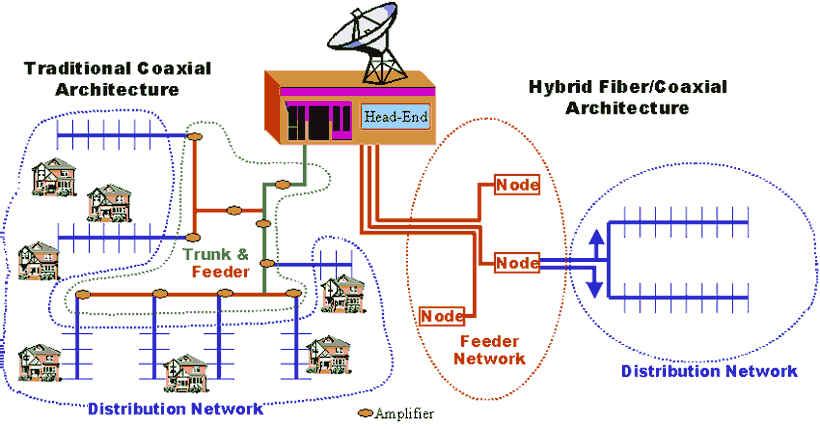
As CATV operators began expanding into telephone, data, and Internet access services, they began transitioning their traditional networks to a Hybrid-Fiber Coaxial architecture, commonly called an HFC network. HFC networks are robust two-way networks that can accommodate both data and internet services in addition to traditional CATV and video services.
If HFC , it's shown on the left side of Diagram. HFC networks use Optical fiber cables from the headend to feed nodes. The Optical Node serves as an equipment location and the interface point with the distribution network. Here, the optical signal is converted to an electrical signal via RG11 for transmission to the home via ordinary coaxial cables RG6. To minimize, if not eliminate repeaters on the coaxial cables and to provide telephony and Internet access services, the node sizes must be kept relatively small – typically under 1,000 households (in the traditional architecture, node sizes averaged 2,000 homes, but could be many times that size). As adoption of Internet access services increases, fiber-fed node sizes must be further reduced to minimize electrical interference on the remaining coaxial cables.

If the traditional CATV network, it is an all coaxial cable network & shown on the left side of Diagram. The headend receives the TV signal typically from satellite, microwave, or fiber optic feeds. The TV signal is then broadcast to the consumer via Trunk line cable 500JCA/JCAM, 540JCAM, F15 and Drop cable RG11, RG6 architecture. CATV cables are predominately aerial and buried cables. The traditional coaxial architecture is a one-way network and not suited for voice and data communication services.
In the traditional architecture, trunk cables 500JCA/JCAM, 540JCAM, F15 carry the TV signal from the headend to branch points where the signal is via CATV Amplifier to either feeder cables or directly to distribution cables. Additionally, trunk cables may carry the feed to nodes (not shown) where it is then distributed. RG11 cables receive the signal from trunk cables and carry the signal deeper into the community where it is transferred to the distribution cables, which blanket the neighborhood and connect via RG6 cables to consumer.
Solutions Products:
Trunk cable 500,540JCA/JCAM
Drop cable RG11,RG6
F connector
Splitter and Taps
Catv Amplifier
Optical Node
Optical fiber cable